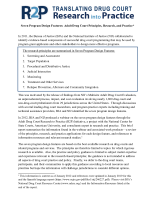Corrections
Innovations in Reentry Initiative
Innovations in Reentry Initiative seeks to improve the capacity and effectiveness of state, local, and tribal jurisdictions to identify innovative ways to increase the success rates of individuals returning to their communities and reduce the number of crimes committed by those recently returning.
Smart Supervision Program
This program provides community supervision agencies with funding, technical assistance, and new tools to improve supervision outcomes.
Body-Worn Camera Partnership Program
This program is for law enforcement agencies, including tribal law enforcement, seeking to pilot, establish, or enhance body-worn camera policy and implementation practices.
Visiting Fellows Program
Through this program, BJA invests in leaders in the field to advance priority national policy issues and offer cross-developmental opportunities for Department of Justice staff and criminal justice practitioners and researchers.
Violent Offender Incarceration and Truth-in-Sentencing Incentive Formula Grant Program
VOI/TIS grant funds allowed states to build or expand correctional facilities to increase the bed capacity for the confinement of persons convicted of Part 1 violent crimes or adjudicated delinquents for an act that, if committed by an adult, would be a Part 1 violent crime.
Justice Reinvestment Initiative (JRI)
This initiative works in partnership with states to analyze complex criminal justice challenges, develop and implement data-driven solutions, and maximize resources to achieve stronger communities and public safety.
Statewide Automated Victim Information and Notification (SAVIN)
This program was created to assist states in building, implementing, and improving victim notification capacity.
State Criminal Alien Assistance Program (SCAAP)
SCAAP provides federal payments to states and localities that incurred correctional officer salary costs for incarcerating undocumented criminal aliens with at least one felony or two misdemeanor convictions for violations of state or local law, and incarcerated for at least 4 consecutive days during the reporting period.
Patrick Leahy Bulletproof Vest Partnership (BVP) Program
This program reimburses states, units of local government, and federally recognized Indian tribes for up to 50 percent of the cost of body armor vests purchased for law enforcement officers.
Residential Substance Abuse Treatment for State Prisoners (RSAT) Program
This program enhances the capabilities of state, local, and tribal governments to provide residential substance use disorder (SUD) treatment to adult and juvenile populations during detention or incarceration, initiate or continue evidence-based SUD treatment in jails, prepare individuals for reintegration into the community, and assist them and their communities throughout the reentry process by delivering community-based treatment and other recovery aftercare services.
Public Safety Officers' Benefits (PSOB) Program
The PSOB Program provides death and education benefits to survivors of fallen law enforcement officers, firefighters, and other first responders, and disability benefits to officers catastrophically injured in the line of duty.
Prison Rape Elimination Act (PREA)
This program provides funding to state and local governments and federally recognized tribes for demonstration projects within confinement settings, including adult prisons and jails, juvenile facilities, community corrections facilities, law enforcement lockups and other temporary holding facilities, and tribal detention facilities.
Prison Industry Enhancement Certification Program (PIECP)
PIECP programs place people who are incarcerated in realistic work environments, pay them prevailing wages, and give them a chance to develop marketable skills that will increase their potential for rehabilitation and meaningful employment on release.
Comprehensive Opioid, Stimulant, and Substance Use Program (COSSUP)
This program aims to reduce the impact of opioids, stimulants, and other substances on individuals and communities by supporting comprehensive, collaborative initiatives.
Justice and Mental Health Collaboration Program (JMHCP)
This program supports innovative cross-system collaboration to improve responses to and outcomes for individuals with mental health disorders or co-occurring mental health and substance use disorders who are in the justice system or reentering the community.
Public Benefit Conveyance Program
BJA's role in this program is to make recommendations as to whether (1) the use proposed by the state or unit of local government meets the requirements of the statute; and (2) the environmental impact of the proposed transfer has been properly assessed under the National Environmental Policy Act.


